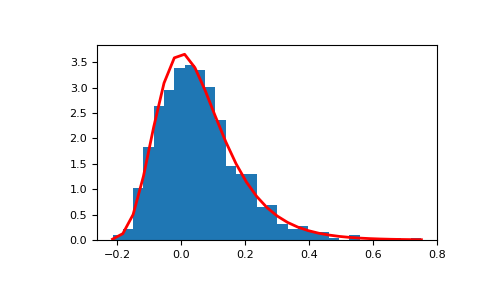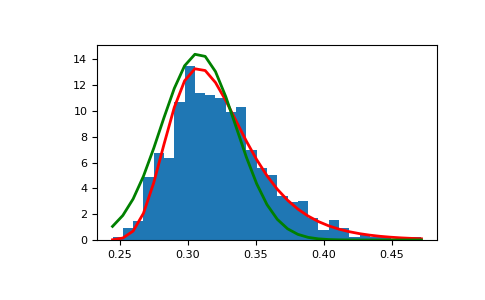numpy.random.RandomState.gumbel¶
-
RandomState.gumbel(loc=0.0, scale=1.0, size=None)¶ 从Gumbel分布绘制样本。
从具有指定位置和比例的Gumbel分布绘制样本。有关Gumbel分发的更多信息,请参阅下面的注释和参考。
参数: loc:float
分布模式的位置。
scale:float
分布的比例参数。
size:int或tuple的整数,可选
输出形状。如果给定形状是例如
(m, n, k),则m * n * k默认值为None,在这种情况下返回单个值。返回: samples:ndarray或scalar
笔记
Gumbel(或最小极值(SEV)或最小极值类型I)分布是用于建模极值问题的一类广义极值(GEV)分布之一。Gumbel是极值类型I分布的特殊情况,最大值来自具有“指数样”尾部的分布。
Gumbel分布的概率密度是
其中
 是模式,位置参数,
是模式,位置参数, 是缩放参数。
是缩放参数。Gumbel(命名为德国数学家Emil Julius Gumbel)早在水文学文献中用于对洪水事件的发生进行建模。它也用于建模最大风速和降雨率。它是一个“胖尾”分布 - 在分布尾部的事件的概率大于如果使用高斯分布的概率,因此出人意料地频繁发生100年的洪水。洪水最初被建模为高斯过程,低估了极端事件的频率。
它是一类极端值分布,广义极值(GEV)分布,其中还包括Weibull和Frechet。
该函数的平均值为
 ,方差为
,方差为 。
。参考文献
[R152] Gumbel,E.J。,“极端统计”,纽约:哥伦比亚大学出版社,1958。 [R153] Reiss,R.-D.和Thomas,M.,“来自保险,金融,水文和其他领域的极端价值的统计分析”,巴塞尔:Birkhauser Verlag,2001。 例子
从分布绘制样本:
>>> mu, beta = 0, 0.1 # location and scale >>> s = np.random.gumbel(mu, beta, 1000)
显示样本的直方图,以及概率密度函数:
>>> import matplotlib.pyplot as plt >>> count, bins, ignored = plt.hist(s, 30, normed=True) >>> plt.plot(bins, (1/beta)*np.exp(-(bins - mu)/beta) ... * np.exp( -np.exp( -(bins - mu) /beta) ), ... linewidth=2, color='r') >>> plt.show()

显示如何从高斯过程中产生极值分布,并与高斯比较:
>>> means = [] >>> maxima = [] >>> for i in range(0,1000) : ... a = np.random.normal(mu, beta, 1000) ... means.append(a.mean()) ... maxima.append(a.max()) >>> count, bins, ignored = plt.hist(maxima, 30, normed=True) >>> beta = np.std(maxima) * np.sqrt(6) / np.pi >>> mu = np.mean(maxima) - 0.57721*beta >>> plt.plot(bins, (1/beta)*np.exp(-(bins - mu)/beta) ... * np.exp(-np.exp(-(bins - mu)/beta)), ... linewidth=2, color='r') >>> plt.plot(bins, 1/(beta * np.sqrt(2 * np.pi)) ... * np.exp(-(bins - mu)**2 / (2 * beta**2)), ... linewidth=2, color='g') >>> plt.show()
